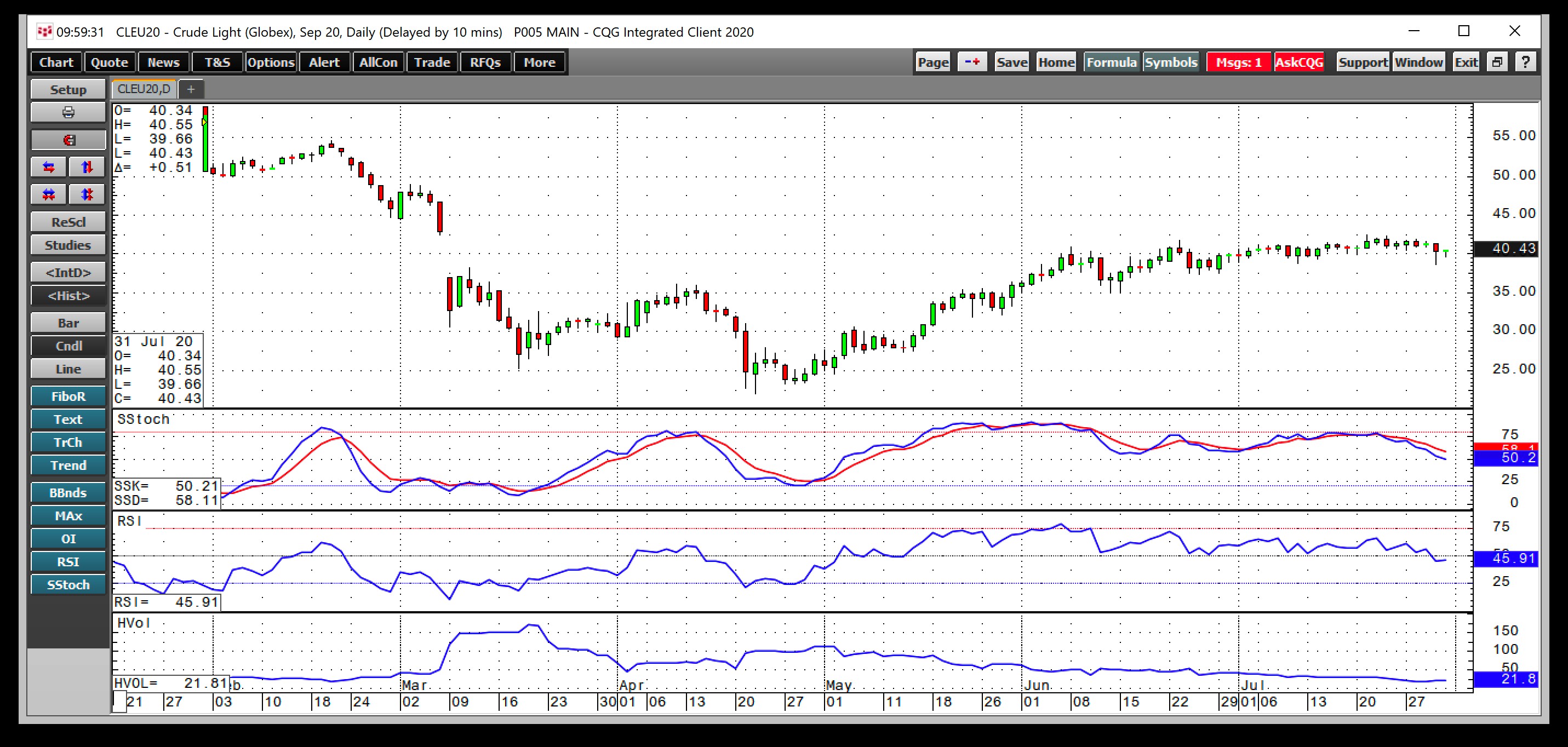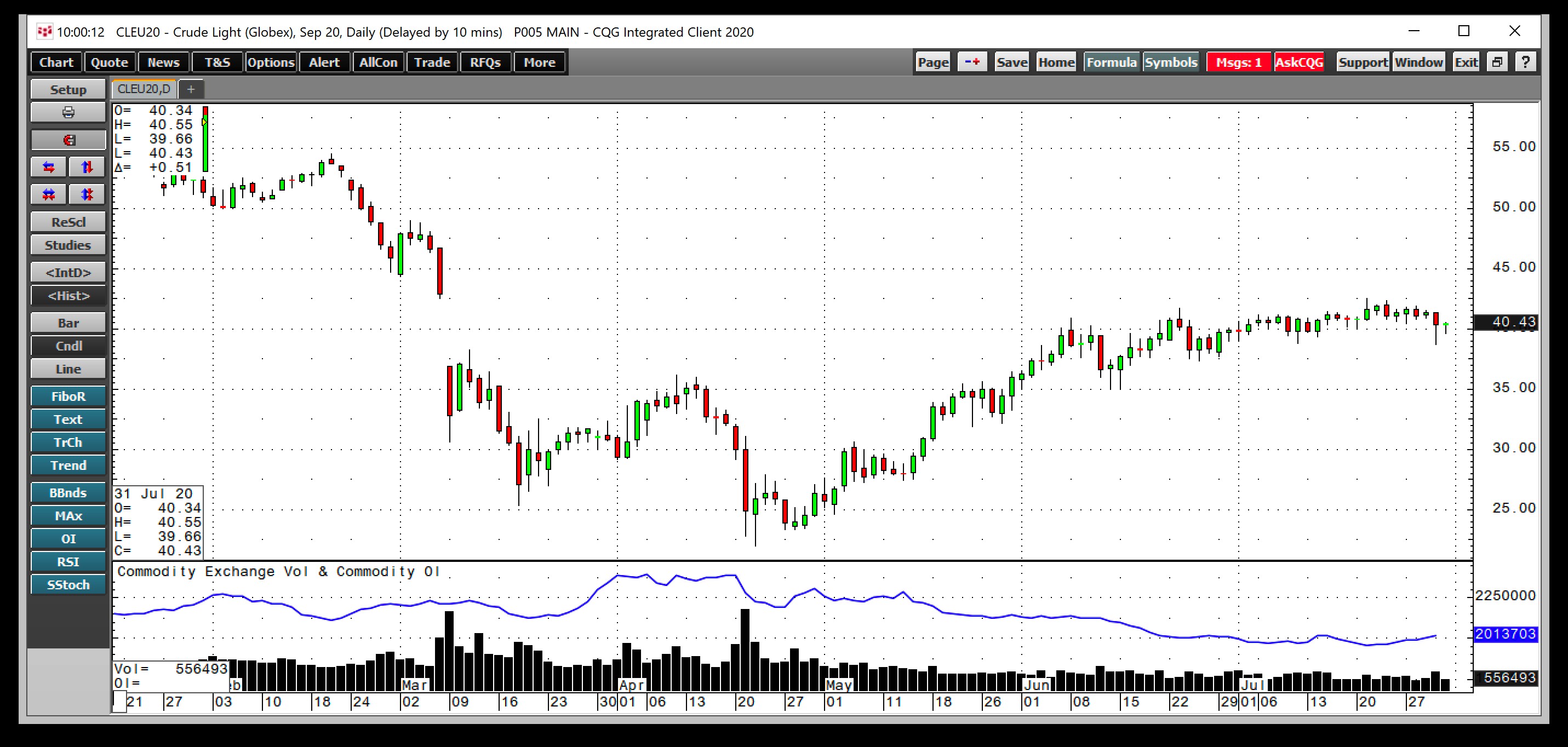Crude oil is about to enter its third month of price consolidation around the $40-per-barrel level on the nearby NYMEX WTI futures contract. After trading to a negative price in late April, the energy commodity staged an impressive comeback on the back of production cuts from OPEC, Russia and other world producers. Simultaneously, the leading producing country, the United States, has experienced a downturn in output because of lower prices. According to Baker Hughes, the number of operating oil rigs in the U.S. was at 180 as of July 31, 590 lower than at the end of July 2019. Last week, the Energy Information Administration reported that daily output was at 11.1 million barrels per day, over 15% lower than the level in March 2020.
Production has declined, but so has demand for the energy commodity, which faces bullish and bearish factors as it sits at straddles the $40-per-barrel level. The crude oil market is starting to look like a tightly coiled spring that could break out of its trading range in dramatic fashion. The United States Oil Fund (NYSE:USO) tracks the price action in a portfolio of active month NYMEX ETI futures contracts.
Toying With $40 Per Barrel Since June
After an more than $80-per-barrel move from negative $40.32 per barrel on the nearby NYMEX crude oil futures contract, the price of the energy commodity has gone to sleep at around the $40 level. The nearby September futures contract rallied from a low of $21.99 on April 22 to $40.27 per barrel as of July 31.
As the daily chart highlights, price momentum and relative strength indicators were sitting near neutral readings at the end of last week. Daily historical volatility on the September futures contract, which peaked at almost 172% in mid-March, was at 21.8% on July 31. The oil market has been flat-lining and consolidating around the $40 per barrel level.

Source: CQG
Open Interest Trending Lower
Open interest is the total number of open long and short positions in a futures market.

Source: CQG
The daily chart shows that open interest in the NYMEX crude oil futures market rose to a peak of 2.293 million contracts in early April, which was the high for 2020. Since then, the metric has steadily declined and was sitting at the 2.014 million contract level at the end of last week, a decline of 12.2%.
The wild price action in April and the consolidation period has caused many speculators to exit risk positions in the oil market. At the same time, lower demand because of the global pandemic and falling production has decreased the hedging requirements for consumers and producers.
The lower level of open interest could eventually cause a sudden price move if a herd or buyers or sellers return to the futures arena.
Two Bullish Signs: Price Action After The Taper And Even Though Number of Cases In U.S. Rises
The potential for another period where business activity in the U.S. and worldwide comes to a halt because of the virus is likely preventing a continuation of the rally in crude oil that began in late April.
Meanwhile, the crude oil market received two signals over the past weeks that could mean higher prices are on the horizon. OPEC, Russia and other producing nations tapered their production cuts from 9.7 to 7.7 million barrels starting on Aug. 1. The oil market responded to an increase in production of 2 million barrels per day with hardly a yawn.
Over the past weeks, the number of coronavirus cases in the U.S. turned dramatically higher. Florida, Texas, Arizona and other states experienced a rise in cases and fatalities. While politicians debated how to address the pandemic’s impact, the price of crude oil remained steady and closed last week at just above $40 per barrel on the September futures contract.
The tapering of the production cut and an increasing number of virus cases could have weighed on the crude oil price. When a market shrugs off bearish news, it is often a sign that the path of least resistance will eventually turn higher. At the same time, the US Dollar Index fell below its technical support level last week. Since the dollar is the pricing mechanism for the crude oil market, a weaker dollar tends to be a bullish factor for the energy commodity.
Crude oil is becoming a tightly coiled spring at the $40 per barrel level. When it decides to move, watch out. A substantial move could be on the horizon.
